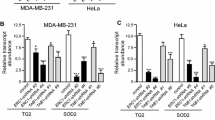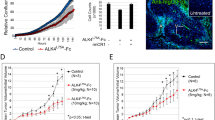Abstract
Nitric oxide (NO), a free radical, has been implicated in the biology of human cancers, including breast cancer, yet it is still unclear how NO affects tumor development and propagation. We herein gradually adapted four human breast adenocarcinoma cell lines (BT-20, Hs578T, T-47D, and MCF-7) to increasing concentrations of the NO donor DETA-NONOate up to 600 μM. The resulting model system consisted of a set of fully adapted high nitric oxide (“HNO”) cell lines that are biologically different from the “parent” cell lines from which they originated. Although each of the four parent and HNO cell lines had identical morphologic appearance, the HNO cells grew faster than their corresponding parent cells and were resistant to both nitrogen- and oxygen-based free radicals. These cell lines serve as a novel tool to study the role of NO in breast cancer progression and potentially can be used to predict the therapeutic response leading to more efficient therapeutic regimens.





Similar content being viewed by others
References
U.S. Cancer Statistics Working Group, United states cancer statistics: 1999-2005 incidence and mortality web-based report. (2009) http://www.cdc.gov./uscs, Accessed May 14, 2009.
Gonzalez-Anqulo AM, Morales-Vasquez F, Hortobagyi GN. Overview of resistance to systemic therapy in patients with breast cancer. Adv Exp Med Biol. 2007;608:1–22.
Yamaguchi Y, Hayashi S. Estrogen-related cancer microenvironment of breast carcinoma. Endocr J. 2009;56:1–7.
Sonnenberg M, van der Kuip H, Haubeis S, Fritz P, Schroth W, Friedel G, et al. Highly variable response to cytotoxic chemotherapy in carcinoma-associated fibroblasts (CAFs) from lung and breast. BMC Cancer. 2008;8:364.
Radisky ES, Radisky DC. Stromal induction of breast cancer: inflammation and invasion. Rev Endocr Metab Disord. 2007;8:279–87.
Bentz BG, Haines III GK, Radosevich JA. Increased protein nitrosylation in head and neck squamous cell carcinoma. Head Neck. 2000;22:64–70.
Hibbs JB, Vavrin A, Taintor RR. L-arginine is required for expression of the activated macrophage effector mechanism causing selective metabolic inhibition in target cells. J Immunol. 1987;138:550–65.
Jenkins DC, Charles IG, Thomsen LL, Moss DW, Holmes LS, Baylis SA, et al. Roles of nitric oxide in tumor growth. Proc Natl Acad Sci USA. 1995;92:4392–6.
Thomas DD, Ridnour LA, Isenberg JS, Flores-Santana W, Switzer CH, Donzelli S, et al. The chemical biology of nitric oxide: implications in cellular signaling. Free Radic Biol Med. 2008;45:18–31.
Thomas DD, Espey MG, Ridnour LA, Hofseth LJ, Mancardi D, Harris CC, et al. Hypoxic inducible factor 1alpha, extracellular signal-regulated kinase, and p53 are regulated by distinct threshold concentrations of nitric oxide. Proc Natl Acad Sci USA. 2004;101:8894–9.
Zhou J, Schmid T, Brune B. HIF-1alpha and p53 as targets of NO in affecting cell proliferation, death and adaptation. Curr Mol Med. 2004;4:741–51.
Ridnour LA, Thomas DD, Switzer C, Flores-Santana W, Isenberg JS, Ambs S, et al. Molecular mechanisms for discrete nitric oxide levels in cancer. Nitric Oxide. 2008;19:73–6.
Ridnour LA, Thomas DD, Donzelli S, Espey MG, Roberts DD, Wink DA, et al. The biphasic nature of nitric oxide responses in tumor biology. Antioxid Redox Signal. 2006;8:1329–37.
Wink DA, Mitchell JB. Chemical biology of nitric oxide: insights into regulatory, cytotoxic, and cytoprotective mechanisms of nitric oxide. Free Radic Biol Med. 1998;25:434–56.
Bentz BG, Haines III GK, Hanson DG, Radosevich JA. Endothelial constitutive nitric oxide synthase (ecNOS) localization in normal and neoplastic salivary tissue. Head Neck. 1998;20:304–9.
Bentz BG, Haines III GK, Lingen MW, Pelzer HJ, Hanson DG, Radosevich JA. Nitric oxide synthase type 3 is increased in squamous hyperplasia, dysplasia, and squamous cell carcinoma of the head and neck. Ann Otol Rhinol Laryngol. 1999;108:781–7.
Chandra R, Haines III GK, Bentz BG, Shah P, Robinson AM, Radosevich JA. Expression of nitric oxide synthase type 3 in reflux-induced esophageal lesions. Otolaryngol Head Neck Surg. 2001;124:442–7.
Chen HHW, Su W-C, Chou C-Y, Guo H-R, Ho S-Y, Que J, et al. Increased expression of nitric oxide synthase and cyclooxygenase-2 is associated with poor survival in cervical cancer treated with radiotherapy. Int J Radiat Oncol Biol Phys. 2005;63:1093–100.
Cobbs CS, Brenman JE, Aldape KD, Bredt DS, Israel MA. Expression of nitric oxide synthase in human central nervous system tumors. Cancer Res. 1994;55:727–30.
Fujimoto H, Sasaki J, Matsumoto M, Suga M, Ando Y, Iggo R, et al. Significant correlation of nitric oxide synthase activity and p53 gene mutation in stage I lung adenocarcinoma. Jpn J Cancer Res. 1998;89:696–702.
Gavilanes J, Moro MA, Lizasoain I, Lorenzo P, Perez A, Leza JC, et al. Nitric oxide synthase activity in human squamous cell carcinoma of the head and neck. Laryngoscope. 1999;109:148–52.
Liu CY, Wang CH, Chen TC, Lin HC, Yu CT, Kuo HP. Increased level of exhaled nitric oxide and up-regulation of inducible nitric oxide synthase in patients with primary lung cancer. Br J Cancer. 1998;78:534–41.
Klotz T, Bloch W, Volberg C, Engelmann U, Addicks K. Selective expression of inducible nitric oxide synthase in human prostate carcinoma. Cancer. 1998;82:1897–903.
Marrogi AJ, Travis WD, Welsh JA, Khan MA, Rahim H, Tazelaar H, et al. Nitric oxide synthase, cyclooxygenase 2, and vascular endothelial growth factor in the angiogenesis of non-small cell lung carcinoma. Clin Cancer Res. 2000;6:4739–44.
Thomsen LL, Farais-Eisner R, Chaudhuri G. Nitric oxide: Role in human cervical cancer. In: Moncada S, Stamler J, Gross S, Higgs EA, editors. The biology of nitric oxide part 5. Proceedings of the 4th international meeting on the biology of nitric oxide. London: Portland Press; 1996. p. 289.
Thomsen LL, Miles DW, Happerfield L, Bobrow LG, Knowles RG, Moncada S. Nitric oxide synthase in human breast cancer. Br J Cancer. 1995;72:41–4.
Nakamura Y, Yasuoka H, Tsujimoto M, Yoshidome K, Nakahara M, Nakao K, et al. Nitric oxide in breast cancer: induction of vascular endothelial growth factor-c and correlation with metastasis and poor prognosis. Clin Cancer Res. 2006;12:1201–7.
Glynn S, Boersma B, Martin D, Howe L, Ridnour L, Wink D, et al. iNOS expression is associated with basal-like breast cancer phenotype and predicts poor survival in ERneg breast cancer. Nitric Oxide. 2007;17:S17.
Duenas-Gonzalez A, Isales CM, del Mar Abad-Hernandez M, Gonzalez-Sarmiento R, Sangueza O, Rodriguez-Commes J. Expression of inducible nitric oxide synthase in breast cancer correlates with metastatic disease. Mod Pathol. 1997;10:645–9.
Bulut AS, Erden E, Sak SD, Doruk H, Kursun N, Dincol D. Significance of inducible nitric oxide synthase expression in benign and malignant breast epithelium: an immunohistochemical study of 151 cases. Virchows Arch. 2005;447:24–30.
Loibl S, Buck A, Strank C, von Minckwitz G, Roller M, Sinn HP, et al. The role of early expression of inducible nitric oxide synthase in human breast cancer. Eur J Cancer. 2005;41:265–71.
Radosevich JA, Elseth KM, Vesper BJ, Tarjan G, Haines III GK. Long-term adaptation of lung tumor cell lines with increasing concentrations of nitric oxide donor. The Open Lung Cancer Journal. 2009;2:35–44.
Hackett AJ, Smith HS, Springer EL, Owens RB, Nelson-Rees WA, Riggs JL, et al. Two syngeneic cell lines from human breast tissue: the aneuploid mammary epithelial (Hs578T) and the diploid myoepithelial (Hs578Bst) cell lines. J Natl Cancer Inst. 1977;58:1795–806.
Lasfargues EY, Ozzello L. Cultivation of human breast carcinomas. J Natl Cancer Inst. 1958;21:1131–47.
Soule HD, Vazquez J, Long A, Albert S, Brennan M. A human cell line from a pleural effusion derived from a breast carcinoma. J Natl Cancer Inst. 1973;51:1409–16.
Keydar I, Chen L, Karby S, Weiss FR, Delarea J, Radu M, et al. Establishment and characterization of a cell line of human breast carcinoma origin. Eur J Cancer. 1979;15:659–70.
Bentz BG, Hammer ND, Milash B, Klein S, Burnett DM, Radosevich JA, et al. The kinetics and redox state of nitric oxide determine the biological consequences in lung adenocarcinoma. Tumor Biol. 2007;28:301–11.
Littlewood-Evans AJ, Bilbe G, Bowler WB, Farley D, Wlodarski B, Kokubo T, et al. The osteoclast-associated protease cathepsin K is expressed in human breast carcinoma. Cancer Res. 1997;57:5386–90.
Smith HS. In vitro properties of epithelial cell lines established from human carcinomas and nonmalignant tissue. J Natl Cancer Inst. 1979;62:225–30.
Castles CG, Fuqua SA, Klotz DM, Hill SM. Expression of a constitutively active estrogen receptor variant in the estrogen receptor-negative BT-20 human breast cancer cell line. Cancer Res. 1993;53:5934–9.
Huguet EL, McMahon JA, McMahon AP, Bicknell R, Harris AL. Differential expression of human Wnt genes 2, 3, 4, and 7B in human breast cell lines and normal and disease states of human breast tissue. Cancer Res. 1994;54:2615–21.
Sugarman BJ, Aggarwal BB, Hass PE, Figari IS, Palladino Jr MA, Shepard HM. Recombinant human tumor necrosis factor-alpha: effects on proliferation of normal and transformed cells in vitro. Science. 1985;230:943–5.
Poutanen M, Moncharmont B, Vihko R. 17 beta-hydroxysteroid dehydrogenase gene expression in human breast cancer cells: regulation of expression by a progestin. Cancer Res. 1992;52:290–4.
Brandes LJ, Hermonat MW. Receptor status and subsequent sensitivity of subclones of MCF-7 human breast cancer cells surviving exposure to diethylstilbestrol. Cancer Res. 1983;43:2831–5.
Acknowledgements
This work was supported by a VA Merit Review Grant (J.A.R.).
Author information
Authors and Affiliations
Corresponding author
Rights and permissions
About this article
Cite this article
Vesper, B.J., Elseth, K.M., Tarjan, G. et al. Long-term adaptation of breast tumor cell lines to high concentrations of nitric oxide. Tumor Biol. 31, 267–275 (2010). https://doi.org/10.1007/s13277-010-0028-6
Received:
Accepted:
Published:
Issue Date:
DOI: https://doi.org/10.1007/s13277-010-0028-6




